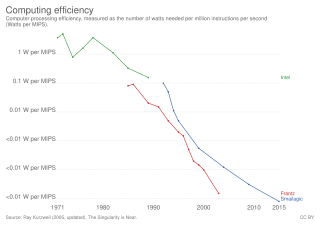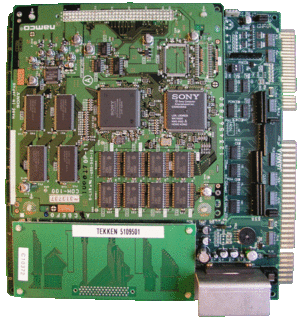Related Research Articles

The Motorola 68000 is a 16/32-bit CISC microprocessor, introduced in 1979 by Motorola Semiconductor Products Sector.

The Motorola 6809 ("sixty-eight-oh-nine") is an 8-bit microprocessor CPU with some 16-bit features from Motorola. It was designed by Terry Ritter and Joel Boney and introduced in 1978. It was a major advance over both its predecessor, the Motorola 6800, and the related MOS Technology 6502. Among the systems to use the 6809 are the TRS-80 Color Computer and Dragon 32/64 home computers, the Vectrex game system, and early 1980s arcade machines including Star Wars, Defender, Robotron: 2084, Joust, and Gyruss. Series II of the Fairlight CMI digital audio workstation and Konami's Time Pilot '84 arcade game each use dual 6809 processors.

Instructions per second (IPS) is a measure of a computer's processor speed. For CISC computers different instructions take different amounts of time, so the value measured depends on the instruction mix; even for comparing processors in the same family the IPS measurement can be problematic. Many reported IPS values have represented "peak" execution rates on artificial instruction sequences with few branches and no cache contention, whereas realistic workloads typically lead to significantly lower IPS values. Memory hierarchy also greatly affects processor performance, an issue barely considered in IPS calculations. Because of these problems, synthetic benchmarks such as Dhrystone are now generally used to estimate computer performance in commonly used applications, and raw IPS has fallen into disuse.

The Neo Geo, stylised as NEO•GEO, also written as NEOGEO, is a cartridge-based arcade system board and fourth-generation home video game console released on April 26, 1990, by Japanese game company SNK Corporation. It was the first system in SNK's Neo Geo family. The Neo Geo was marketed as 24-bit; its CPU is technically a 16/32-bit 68000-based system with an 8/16-bit Z80 coprocessor, while its GPU chipset has a 24-bit graphics data bus.

The Sega Saturn is a home video game console developed by Sega and released on November 22, 1994 in Japan, May 11, 1995 in North America, and July 8, 1995 in Europe. Part of the fifth generation of video game consoles, it was the successor to the successful Sega Genesis. The Saturn has a dual-CPU architecture and eight processors. Its games are in CD-ROM format, and its game library contains several ports of arcade games as well as original games.

The TurboGrafx-16, known as the PC Engine in Japan and France, is a 16-bit fourth-generation home video game console designed by Hudson Soft and sold by NEC Home Electronics. It was released in Japan in 1987, and in North America in 1989. The Japanese model was imported and distributed in France in 1989, and the United Kingdom and Spain received a version based on the American model known as simply TurboGrafx. It was the first console released in the 16-bit era, although it used a modified 8-bit CPU. In Japan, the system was launched as a competitor to the Famicom, but the delayed United States release meant that it ended up competing with the Sega Genesis and later the Super Nintendo Entertainment System.

The Phoebe 2100 was to be Acorn Computers' successor to the Risc PC, slated for release in late 1998. However, in September 1998 Acorn cancelled the project as part of a restructuring of the company.

The X68000 is a home computer created by Sharp Corporation, first released in 1987, sold only in Japan.

The Hyper Neo Geo 64 is an arcade system created by SNK, and released in September 1997, as the successor of the Neo Geo MVS, within the Neo Geo family.
The CP System II or CPS-2 is an arcade system board that Capcom first used in 1993 for Super Street Fighter II. It was the successor to their previous CP System and Capcom Power System Changer arcade hardware and was succeeded by the CP System III hardware in 1996, of which the CPS-2 would outlive by over four years. The arcade system had new releases for it until the end of 2003, ending with Hyper Street Fighter II.

The CP System is an arcade system board developed by Capcom that ran game software stored on removable ROM cartridges. More than two dozen arcade titles were released for CPS-1, before Capcom shifted game development over to its successor, the CP System II.
The CP System III or CPS-3 is an arcade system board that was first used by Capcom in 1996 with the arcade game Red Earth. It was the second successor to the CP System arcade hardware, following the CP System II. It would be the last proprietary system board Capcom would produce before moving on to the Dreamcast-based Naomi platform.
The Namco System 21 "Polygonizer" is an arcade system board unveiled by Namco in 1988 with the game Winning Run. It was the first arcade board specifically designed for 3D polygon processing. The hardware went through significant evolution throughout its lifespan until the last game, Cyber Sled, was released in 1993. It was preceded by the Namco System 2 in 1987 and succeeded by the Namco System 22 in 1993.

The Namco System 22 is the successor to the Namco System 21 arcade system board. It debuted in 1992 with Sim Drive in Japan, followed by a worldwide debut in 1993 with Ridge Racer.

The Namco System 11 is a 32-bit arcade system board developed jointly by Namco and Sony Computer Entertainment. Released in December 1994, it is a successor to the Namco System 22, the company's first 3D arcade system. The System 11 is directly based on the PlayStation, Sony's first home video game console, using a 512 KB operating system and several custom processors. An upgraded version of the System 11, the Namco System 12, was released in 1996 and features a faster processing power. Tekken was the first game to use the System 11.
The Namco System 246 is a development of the Sony PlayStation 2 technology as a basis for an arcade system board. It was released in December 2000 on its first game Bloody Roar 3. Like the Sega NAOMI, it is widely licensed for use by other manufacturers. Games such as Battle Gear 3 and Capcom Fighting Evolution are examples of System 246-based arcade games that are not Namco products.
The Williams Pinball Controller (WPC) is an arcade system board used for several pinball games designed by Williams and Midway between 1990 and early 1999. It is the successor to their earlier System 11 hardware. It was succeeded by Williams/Midway's Pinball 2000 platform, before Williams left the pinball business in October 1999.
The Namco System N2 arcade platform runs on an nForce2-based motherboard that NVIDIA developed. It is based on a NVIDIA GeForce graphics card, using the OpenGL API.
Atari System refers to two arcade system boards introduced in 1984 for use in various arcade games from Atari Games. Two versions of the board were released, Atari System 1 and Atari System 2.